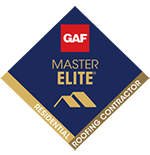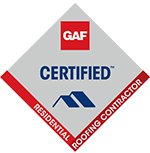As a homeowner, your roof is one of the most important components of your property. Not only does it protect the rest of your home from the elements, it is also an integral part of its aesthetic appeal. As such, you want to make sure that any roof leaks are identified and repaired quickly and correctly, before they get out of hand.We are here to provide you with a comprehensive guide on how to identify and repair roof leaks, in order to keep your home looking great and functioning properly for years to come. As a note: Roman Roofing does not endorse DIY repairs as a stable alternative to professional roofing.
Identifying Roof Leaks
The first step in repairing a leaky roof is identifying where the leak is coming from. This can be tricky because some sources may not be immediately visible or apparent. The best way to start is by inspecting both interior and exterior areas adjacent to where you suspect there may be a problem; this includes checking attic spaces as well as any pipes or vents that are connected directly to the outside walls. If there are no signs of obvious damage or water infiltration around these areas then it’s time to take a closer look at your actual roofing material – whether it’s tile, metal shingle, etc – for signs of wear-and-tear such as gaps between tiles/shakes or loose nails/screws around flashing points like chimneys or skylights.
Repairing Roof Leaks
Once you have identified any potential sources of water infiltration into your home through its roof structure, then you can begin making repairs, using GAF products specifically designed for each type of material (tile/metal/asphalt). For example: if you find that individual tiles have become dislodged due to wear-and-tear then GAF has tile repair kits which include all necessary materials including adhesives & tapes; similarly they also offer metal shingle repair kits containing sealants & reinforcements along with other necessary items needed for patching up damaged sections without having replace entire sheets altogether (which could potentially cost much more money depending on size).
Inspections & Maintenance
It’s important not only to understand how to identify and repair issues but also maintain your roof’s overall health by scheduling regular inspections every 2 – 3 years depending on climate conditions in the area (4 – 5 years if living somewhere with milder weather). During these inspections technicians should check for common problems like missing/cracked tiles or shakes along with correct installation techniques used during the initial construction phase as well . Additionally they should also inspect gutters & downspouts, ensuring proper drainage away from the house. This ultimately helps prevent future leaks from occuring due to structural damages caused by pooling rainwater over time (this type of damage typically takes longer to fix than simpler tile replacement jobs) .
Plan For Success, and Reach Out
Having an effective plan in place when dealing with potential leaking roofs will ensure that minor issues don’t turn into major disasters down line costing thousands dollars worth unnecessary repairs & replacements . With help from products provided by brands like GAF, homeowners now have access to quality materials backed by a warranty, guaranteeing their durability even under extreme weather conditions. If still unsure what steps to take next , contact Roman Roofing today to see how we can help get the problem fixed quickly while still staying within budget!
Subscribe to Roman Roofing's Blog




